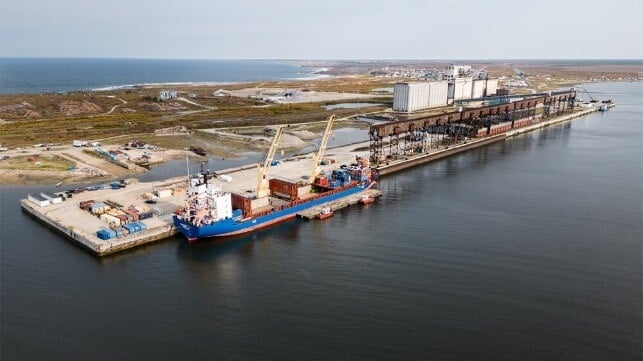Canada Looks to Accelerate Development of Far North Port of Churchill

The idea of developing the Port of Churchill, located in Manitoba in the reaches of the Arctic, has been gaining momentum in Canada. Now, with the country finding itself in trade disputes with the United States and seeing new opportunities in oil and gas, the once distant port is taking on new importance.
Twenty years ago, the then ministers for Manitoba and the federal Minister for Western Economic Diversification first promoted the idea of expanding the port. In 2005, they announced C$2 million investment along with a further C$1 million from the Hudson Bay Railway Company to invest in the port. They were looking to develop containerized traffic flow and use of the port for two-way movement of heavy machinery, fertilizer, and ores.
The port was developed in the 1920s and today is managed by the Arctic Gateway Group, an Indigenous- and community-owned corporation operating the port as well as the railway. They point out that the Port of Churchill is Canada’s only Arctic deepwater seaport serviced by rail, as well as the Hudson Bay Railway. It has four deep-sea berths as well as storage capabilities, and vitally important the rail link.
Located on the west coast of Hudson Bay, they point out that it offers shorter shipping routes to Europe. The proximity they said to the central Arctic also makes it a vital link for the local communities.
Now, with Canada finding itself at odds with the United States, Churchill is drawing new attention. The new Energy Minister, Tim Hodgson, spoke with Bloomberg this week, promoting the “tremendous potential: for Churchill. He dismissed concerns about its northern location, pointing out that it is on the same latitude as Oslo. Concerns about the port being icebound for many months were countered with the fact that Canada is building a new generation of icebreakers. It was also pointed out that Russia is opening up the Arctic to global shipping.
Hodgson told Bloomberg, “I think there is an opportunity to make Churchill a far more strategic port.” It was originally developed for the shipment of grain, but today they see a strong potential in natural resources such as gas and potash.
Canada recently joined the international market for LNG with the opening of its first export terminal in British Columbia. It was pointed out that it provides strong advantages to the Asian markets, especially versus U.S. shipments from the Gulf that have to transit the Panama Canal to Asia.
Now Canada is looking to the east, and the strong demand for gas imports from Europe. Several ideas are being promoted to pipe oil and gas east in Canada. Churchill, it is pointed out, would make a natural terminus and provide access to the European markets.
Yesterday, August 7, the Canadian government issued a request for proposals to conduct a study to explore the feasibility of a west-east pipeline. The government of Ontario is proposing to bring oil and gas east to its refineries. It also presents its ports as another option for export terminals.
“The Port of Churchill and Hudson Bay Railway are ready to provide Canada with an essential northern trade corridor, reducing dependence on southern routes and strengthening national resilience,” said Chris Avery, CEO of the Arctic Gateway Group. He points out that they have rebuilt and modernized the railway.
The Government of Manitoba in March also recognized the potential of the port and included investments in its new budget. These will be used for further development in critical mineral storage, grain handling, and continued rail modernization.
“Arctic Gateway is ready to take on a greater role in Canada’s trade and security future, growing the northern economy and creating good northern jobs,” says Avery. He points out the port is already seeing increased demand, with growing shipments of critical minerals and new import and export partnerships to help Canadian agricultural producers diversify and strengthen their supply chains.
